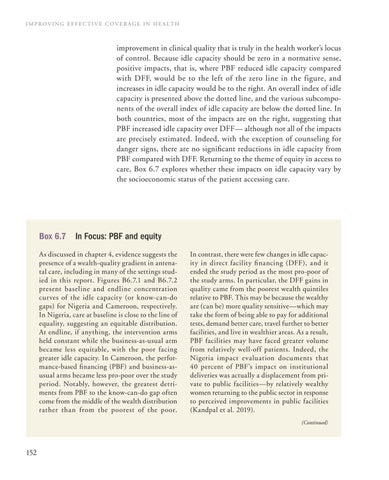IMPROVING EFFECTIVE COVERAGE IN HEALTH
improvement in clinical quality that is truly in the health worker’s locus of control. Because idle capacity should be zero in a normative sense, positive impacts, that is, where PBF reduced idle capacity compared with DFF, would be to the left of the zero line in the figure, and increases in idle capacity would be to the right. An overall index of idle capacity is presented above the dotted line, and the various subcomponents of the overall index of idle capacity are below the dotted line. In both countries, most of the impacts are on the right, suggesting that PBF increased idle capacity over DFF— although not all of the impacts are precisely estimated. Indeed, with the exception of counseling for danger signs, there are no significant reductions in idle capacity from PBF compared with DFF. Returning to the theme of equity in access to care, Box 6.7 explores whether these impacts on idle capacity vary by the socioeconomic status of the patient accessing care.
Box 6.7 In Focus: PBF and equity As discussed in chapter 4, evidence suggests the presence of a wealth-quality gradient in antenatal care, including in many of the settings studied in this report. Figures B6.7.1 and B6.7.2 present baseline and endline concentration curves of the idle capacity (or know-can-do gaps) for Nigeria and Cameroon, respectively. In Nigeria, care at baseline is close to the line of equality, suggesting an equitable distribution. At endline, if anything, the intervention arms held constant while the business-as-usual arm became less equitable, with the poor facing greater idle capacity. In Cameroon, the performance-based financing (PBF) and business-asusual arms became less pro-poor over the study period. Notably, however, the greatest detriments from PBF to the know-can-do gap often come from the middle of the wealth distribution rather than from the poorest of the poor.
In contrast, there were few changes in idle capacity in direct facility financing (DFF), and it ended the study period as the most pro-poor of the study arms. In particular, the DFF gains in quality came from the poorest wealth quintiles relative to PBF. This may be because the wealthy are (can be) more quality sensitive—which may take the form of being able to pay for additional tests, demand better care, travel further to better facilities, and live in wealthier areas. As a result, PBF facilities may have faced greater volume from relatively well-off patients. Indeed, the Nigeria impact evaluation documents that 40 percent of PBF’s impact on institutional deliveries was actually a displacement from private to public facilities—by relatively wealthy women returning to the public sector in response to perceived improvements in public facilities (Kandpal et al. 2019). (Continued)
152

